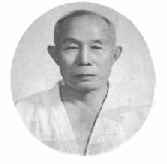Brief History of Hapkido
It is generally accepted that the nucleus of the martial arts was formed when Bodhidharma (480-528, the 1st patriarch of Zen and the 28th patriarch of Buddhism) made an epic trek across the Himalayas and arrived at the Song Shan Shaolin Temple. He introduced Zen to the temple in the year 520.
Korea and the Hwarang
At the time when the great religions of China began to penetrate southward, the Korean peninsula was divided into three kingdoms. Silla, being the smallest, was under constant attack from its two neighbors: Paekche to the west and Koguryo to the north. Buddhism was already several hundred years old in the northern kingdoms before it was introduced to the southern tip of the Korean peninsula in the small kingdom of Silla. Buddhism was introduced to Silla by two monks from Koguryo in the latter half of the fifth century, but it was another hundred years before Buddhism took root and won general acceptance. Under the reign of King Pophung, Buddhism became the sanctioned state religion of Silla. With the advent of religion came the written language, culture, and the arts. It was the beginning of a great period in Korean history.
In the year 540 a new monarch by the name of King Chinhung came to power in Silla. One of the most significant acts by the King was the creation of the hwarang warrior. To accomplish this, he called upon a famous Buddhist Priest, Won Kwang Bopsa, who developed a system of martial arts that was in harmony with his concept of the laws of nature.
Based on the concept of the unity (um-yang), the empty hand fighting techniques were known for their blending of the soft and hard hand techniques and for their linear and circular foot techniques. Some years later, China and Silla were in alliance in a war against Paekche. The Silla armies had engaged Paekche in a battle and defeated them. It was through the efforts of the hwarang that the kingdoms were united.
Hwarang chivalry endured throughout the Silla and Koryo dynasties and was the driving force that formed the basis for the modern state of Korea. In 1392, General Sung Key Yi overthrew the Koryo Dynasty and established the Yi Dynasty. During the Yi Dynasty (1392-1910), the martial arts fell into decline. During the Japanese occupation of 1905 until the end of World War II, the martial arts in Korea were suppressed even further.

The Founder and his Studies
Hapkido was developed by Yong Sul Choi (1904-1986). Master Choi moved to Japan in 1911 (due to the Japanese occupation of Korea) where he was adopted into the family of Sokaku Takeda. Sokaku Takeda (1860-1943) was the head of the ancient Japanese martial art of daito ryu aikijujutsu.
Aikijujutsu was founded by Prince Teijun, the sixth son of the Emperor Seiwa (850-880) who was the 56th ruler of Japan. Tsunamoto, Prince Teijun’s eldest son, was given the name Minamoto and the art was passed on to succeeding generations of the Minamoto family. By the time the art had reached Yoshimitsu Minamoto (1056-1127), the foundation had already been laid. Yoshimitsu Minamoto is regarded as the actual founder of the daito ryu (the “great eastern style” of aikijujutsu).
Yoshimitsu Minamoto’s grandson, Yoshikiyo Minamoto (some records indicate that Yoshikiyo may have been the second son of Yoshimitsu), founded the Takeda branch of the Minamoto family in the province of Kai. In 1574, Kunitsugu Takeda established the Takeda family in the province of Aizu. Thereafter the art remained an exclusively samurai practice and was handed down within the family until Japan emerged from isolation into the Meiji period of 1868.
During the Meiji period, Sokaku Takeda became the head of daito ryu aikijujutsu as well as the link between ancient and modern martial arts. Yong Sul Choi trained and lived with Sokaku Takeda for many decades. Following World War II, Yong Sul Choi returned to Korea with the blessings of Sokaku Takeda to spread his discipline.